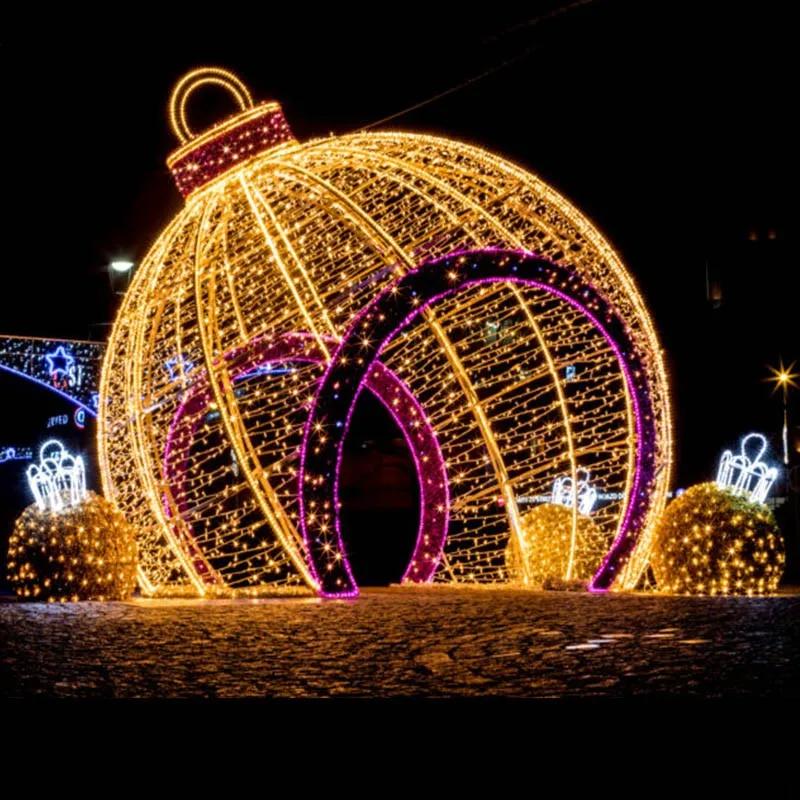The History of outdoor Christmas Lights

Christmas lights have come a long way since their inception in the 17th century. They are a Christmas tradition that has strongly withstood time; outdoor Christmas light displays on houses stemmed from the trend of lighting up Christmas trees during the Christmas season. Outdoor Christmas light displays bring both joy and a competitive spirit out of people across the world as Christmas approaches every year.
Candles - Outdoor Christmas light displays on houses evolved from decorating the traditional Christmas tree and house with candles during the Christmas season. The tradition of lighting the tree with small candles dates back to the 17th century and originated in Germany before spreading to Eastern Europe. The small candles were attached to the tree branches with pins or melted wax. In addition, European Christians used to display a burning candle in the windows of their house that was visible from the outside. The candles in the window indicated to other Christians that the house was a Christian house and that other Christians were welcome to come worship with the residents.
Thomas Edison and Edward Johnson - During the 1880 Christmas season, Thomas Edison introduced the first outdoor electric Christmas light display to the world. He displayed the lights outside of his laboratory compound, which sat near a railway where many people could see it each night. This was the first official outdoor Christmas display that was separate from decorating just the Christmas tree.
Edward Johnson, who was an inventor under the supervision of Thomas Edison, created the first string of Christmas lights a couple of years later. The string of lights was made out of 80 small electric light bulbs. In 1890, the strings of lights were mass-produced and department stores began displaying them in Christmas displays in their stores. Public displays of Christmas lights in retail stores and government buildings became more popular in the U.S. at the turn of the 20th century and gave way to outdoor displays on homes a few decades later when the electric lights became more affordable.
Dangerous and Expensive - As the trend took off, it became apparent that lighting up the Christmas tree and house definitely took effort and money. For many people, the only Christmas light display option was to light up the tree with candles, because they could not afford to buy lights. The trees would be displayed for only a couple of days before Christmas, and the candles were only lit for a few minutes at night, a far cry from the elaborate tree and home displays we are familiar with today. People were aware of the fire dangers and kept buckets of water and sand nearby in case the tree caught fire. The lit tree was often placed in front of a window for people outside the house to see.
In 1895, the first White House electrically lit Christmas tree was sponsored by President Grover Cleveland, which brought national attention to the trend. At the time, only wealthy people could afford the cost, which was upward of $300 per season (which would be more than $2,000 in 2010).
Today's Christmas Lights - The incandescent Christmas lights that cheerfully light up the dark days of December have come a long way. Candles on trees and in windows have given way to massive outdoor displays that attract visitors from miles away. The mini light is the most popular light style, and most of these lights come with a built-in twinkle. There are different incandescent light sizes offered today, and most function in the same manner. Light-emitting diode, or LED, lights are energy-efficient and help reduce carbon emissions and your electric bill. Christmas light displays often bring out people's competitive spirit to see who can have the most elaborate display on their street. (Source)
What Do Blue Holiday Lights Mean?
Stringing holiday lights on trees and homes is a widely followed tradition observed by millions of people worldwide. Red and green are probably the most popular choice for holiday lights, followed by classic white. However, blue lights have been making a comeback in popularity in recent years.
The history of holiday lights - The tradition of stringing holiday lights is one that finds its origins in the celebration of Yule. Yule started in Germany in the Fourth century, when people celebrated the winter solstice and shorter days by burning a Yule log that was supposed to offer "welcome light on dark days" and "beckon back the sun, while warding off evil spirits." Christian churches adopted this tradition; over the centuries, the Yule tradition transformed to stringing lights onto a tree.
Spirit of the season - One common belief is that red represents passion, green represents vitality, yellow represents brilliance, white represents purity and blue represents a generosity of spirit. (Source)
How many of you went around the neighborhood with your family to look at the Christmas house decorations. That was my favorite part of the holidays when my parents, sister and I would get in the car to see how people decorated their homes. My husband and I followed suit with my children and now my son does it with his children. The last couple of years I've seen a competition on TV called the Christmas Great Light Fight. Now those are some decorations to see. I'll post a video below.
If any of you decorate your home please take a picture and share it with us. If you don't, then how about sharing some Google images here.
Comments
-
Tagging active Community Hub Players into spoiler :
@Yosca @Fakhri @Elsa @siti_payung @Sukanta_Biswas @christine88 @encantes @DeepshikhaSharan @Sharon_Loose @Acv @Sammyjo @aijaziqbal @hechicerilla @wykoon @teresawallace44 @Pitty_Kitty @Tzvi_Marcu @fabke @ChrisMiller @CerbeRus777 @Cats4Caz @GlenysB @laley @Roary2020 @CassD @Bookster @Andres-2 @Tasty_Cake @nguyenanhduy1591999 @littlemissmim08 @santo_chris97 @rebelchild @istuff @carmenechevarria @Lexi @Glenn1972 @SabrinaM @johamilton @kiara_wael @Werner_Cichy @Nat09 @bearwithme @paul5473 @candycrushinit @gr33n3y3z @tininha1975 @LoveDachs @PrettyBubbles @MountainMom @Princess_lovely @Yorben_Goeree @rajdeeptb @Nix66 @NamTruong2001 @Anahita_2005 @simplyP @Origins7_Dale @Iffu2 @me6412 @DieOmimi @Greymane @yonahselcy @jeanps @BubbleGumSoda @bekicrusher @Kezabelle3 @Nwosu @Nikolaos_Prodromidis @pearl_chetna @S_u_n_s_h_i_n_e @lelensp @JoJo75durham @DaniTheOG @Racoon7 @lhalha @tashanight3 @Shilviya18 @actipton80 @shafer223 @MollyS @DGenevieve @Moh1977 @BQN537 @Palash_Sarma @bkychau @aautz1 @Nadia1770 @EOTheGr8 @a_trost @Havish @AaronMedina @Lemurtek @KCullen127 @ndaoz @penken @Spinnifix @lakiere @BlueberryCupcake @quad5 @JessicaBilly @Nenikapaki @dlovo313 @betchiegrl29 @MollyMolls @MiladyR @EnergizerBunny @Erika0811 @SUZANCE @ffs @Jessicaa_Welch @Warriorcatslover @hortangel @upperlevel @Terri_1 @Geogat12 @Ashraf @deadgirl @denisegood @gaivman @Staceylou88 @angelae81 @GayAdHd @Solarwave @wbw @DanielProGamer @Hell66 @DocBee @arjankrijger2005 @KhyiBee26 @bunnyjordi @GrammaGaming @Osxar @Temi4real @Tbar2 @nicapepito
** If who wants to subscribe Community Hub Tagging List, please check and comment here! Thanks! 😊 **
Also tagging another active King's Game Players only into spoiler :
BW3S : @Alabamakarla @ArriettyM @abeka8752 @BrendaY12 @DU123 @hiserman @jrite @kittymcaree @LisaMarie @MicheleHogg @MohamedAhmed_84 @penguin123r6 @plewis @StellaDickens @stellanoita @taito2000 @taoneely14 @teoboy @Walezy CCS : @arwen777 @greddycandy @olyamt @rare @MonroeH @candyujwal @Suzanne_Mel @Boybinary @Magic_Mixer @cjay63 @Phillygrl @Barry_Dean_Clark @ckmy @samm_kml @bmkersey08 @Vixsyn2502 @Kiwi2018 @Marzop @nnarkis @MaryLuyo2020 @Sabriny @Beth_Mc_Hugh @Munster @SH_Lee @MiaChristine @KitKathySuzyQ @Colleen12 @annthomas0104 @ashfordgooner @leggylett @babsblake @Paul301153 @coopsj @silentladka @spoekie @arjankrijger2005 @abdulkarim11 @arhammir @WendyG78 @Alexandra_Tang @starlighters101 @KrazeK @Merx_Gonzalez @Fences @dianaperez200 @Byrd59 @Loser9 @Tina_Williams-2 @Scorpio54 @Michael-6 @peggyvereen @Chase_ @fable1707 @ernstbln @Chardonnay @Alsahot11 @InMyOpinionOnly @davis1434 @angelae81 @arkannex @cwsherwood @Marzia333 @Roary2020 @nightshade1066 @KitKathySuzyQ @Colleen12 @Tess92 @maryam60 @br0k3n4ng31 @MiaChristine @Weezy @Goldenswordz @Albert_Heinrich @DarDarW @hmwgreer33 @Sasha2707 @Thomas_Lee @scotiankitty @gillinic @7779 @Tinitun @Jared_Buttry @kdemello101086 @sydisid @jntcbs89 @nacona123 @fares11222 @Delylah @QueenMiah @c69cam @BzKnz @R70Ca1980 @JeffMakesGames @HughLaurie1959 @DoggieMason @Dark_alexa18 @Pteskawin @DemonKneeHigh @janaep @paco1234 @Edwardbright @Johnmeatman @beccasdad @Iman04 @NILAKSHIBAJPAI @Lys7 @Sherry_Ke @tetele_1979 @R70Ca1980 @zeenajaneesh2 @Langlang CCSS : @2easy @Adav @Aitch @Annwat @beanrags @Bricorn @crabapple @dannyalvaro @Deobella @ejurjane @giotaki @Gumyupawpaw @Hinoni @jellyjean @katarzsic @Mookie2 @namal_butt_01 @Pcj @Precious0914 @Riri2 @Soda_bottelet @Tleaf70 @Wen19 @Yaz_Milani CCJS : @janeau_owl @95chata @klev8628 @alex1985 @Pauld77 @tokasa13 CCFS : @little_kay @Kate3A @actress @theredrabbit @gamepower @nobelove @Laurenmlh @AkumaXX @spring_queen_18 @AngelaMariposa @Mattia_ @yukibear @sawasdee @AkumaXX @wozziewoo @Elenna @Chantelle @ellectra @dananelle @jennygirl83 @CVenn @DBlake13 PR : @Joost_Theunis @CarlitaAlfonso @rascallycat @grandmato4 @lbwdesign @jutty @brandyw78 @Gisa77 @Angel1207 @Lei_KC @marimar1971 @amynmugs @CarlaPouzache43 @Stac1017 FH : @10eke @Angel_Natasha @FarkasneKa2020 @Filly_McBean @Grumpy_Old_Man @bramam @meemahh DD : @Andy_Green @spoat @annyman725 @asjbakkie @mozart @bianca70 @annmarie74 @moo_moo_49 @Manda3 @julieschel @Roha @wandamc @froogal @Wallycom @sammiew86 @koepi69 @Diana_Smith @MotshidisiMoea @Donna_White_2_2
Also tagging active Crash On the Run Players into spoiler :
@Denyae0203 @XNtricity @San_King @DebonoChica @Luna_7_Daily @Roan27 @XcrashNplayX @RadoMathan @Disguire @grampacrash @Lisann2112 @Frozenice @MINUZ @Galliranth @MiamiCrash3 @R3gor @pudelbirne @Psycho_Crash @nay410 @Adrenaline @Vanessa_Lionheart @juls_king_acct @mrmapache @BluePowerGem @SylCat @Mohamed90909 @S3shhs3S @Wumpa_Baker @felipesolares
-
-
-
Hello @Elsa , this is again very good information about the tradition of Christmas lighting.
I myself only have a small lighting in my apartment during the Christmas season.
But I can see from my window that there are many people who have great festive lighting in their apartments or on the balconies.
In a city of millions where I live, all the big squares and streets are equipped with lights. This is organized by the city. It's great to look at.
Here are some pictures:
-
-


















